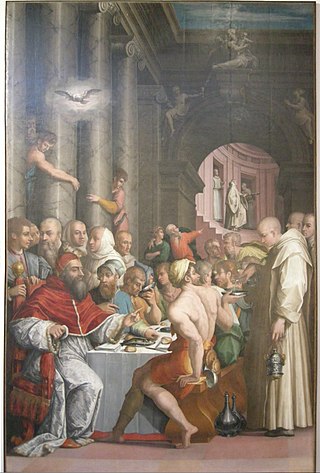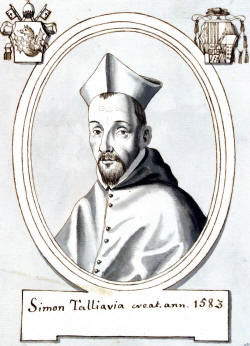
Niccolò Ridolfi was an Italian cardinal.

The Suburbicarian Diocese of Palestrina is a Latin suburbicarian diocese centered on the comune of Palestrina in Italy.

The Diocese of Frascati is a Latin suburbicarian see of the Diocese of Rome and a diocese of the Catholic Church in Italy, based at Frascati, near Rome. The bishop of Frascati is a Cardinal Bishop; from the Latin name of the area, the bishop has also been called Bishop of Tusculum. Tusculum was destroyed in 1191. The bishopric moved from Tusculum to Frascati, a nearby town which is first mentioned in the pontificate of Pope Leo IV. Until 1962, the Cardinal-Bishop was concurrently the diocesan bishop of the see. Pope John XXIII removed the Cardinal Bishops from any actual responsibility in their suburbicarian dioceses and made the title purely honorific.

The 1534 papal conclave was convened after the death of Pope Clement VII, and elected as his successor Cardinal Alessandro Farnese, who became Pope Paul III.

Antonio Pucci was a Cardinal of the Catholic Church.

Alessandro Cesarini, bishop of Pistoia, was an Italian cardinal of the Roman Catholic Church.

Pope Leo X created 42 new cardinals in eight consistories.

Pope Clement VII created 32 new cardinals:

Marco Cornaro, also known as Cardinal Cornaro and Cardinal Cornelius, was an Italian Roman Catholic cardinal and bishop.

Antonio Maria Ciocchi del Monte was an Italian Roman Catholic bishop and cardinal.
Bonifacio Ferrero (1476–1543) was an Italian Roman Catholic bishop and cardinal.

Franciotto Orsini (1473–1534) was an Italian Roman Catholic cardinal.
Paolo Emilio Cesi (1481–1537) was an Italian Roman Catholic cardinal.
Gianvincenzo Carafa (1477–1541) was an Italian Roman Catholic bishop and cardinal.
Gabriel de Gramont (1486–1534) was a French Roman Catholic bishop and cardinal.
Esteban Gabriel Merino was a Spanish Roman Catholic bishop and cardinal.

Uberto Gambara (1489–1549) was an Italian Roman Catholic bishop and cardinal.

Marco Antonio Colonna (1523–1597) was an Italian Roman Catholic bishop and cardinal.

Pedro de Deza (1520–1600) was a Spanish Roman Catholic cardinal and bishop.

Simeone Tagliavia d'Aragonia (1550–1604) was a Sicilian cardinal and bishop.











